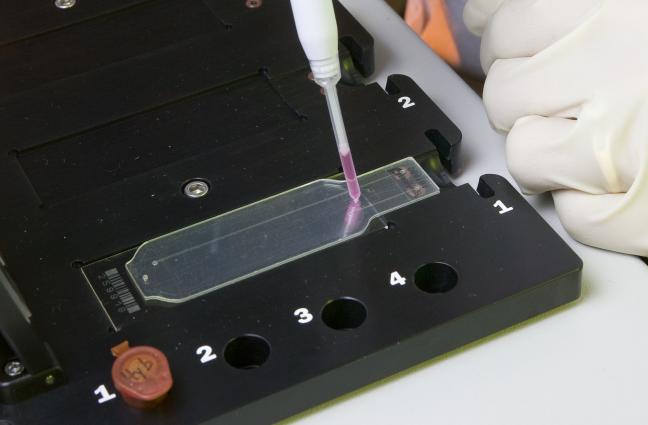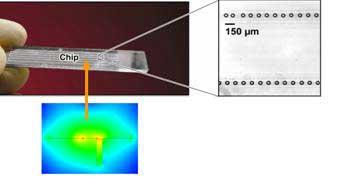"Microfluidic devices" loosely describes a generation of miniaturized instruments that mix, react, count, fractionate, detect, and characterize complex gaseous or liquid-solvated samples. Microfluidic devices are revolutionizing environmental, chemical, biological, medical, and pharmaceutical reactors, detectors, and diagnostics. Most devices perform reactions that require a heating step. Heat transfer rates are the limiting factor in reaction times and therefore the time to results.
LLNL has developed a technology that provides near-instantaneous heating of aqueous samples in microfluidic devices. The method heats samples in a focused area within a microfluidic channel on miniaturized chips. The microwave heating device is composed of a waveguide or microstrip transmission line embedded in a microfluidic channel. Aqueous solution microwave heating allows extremely fast heat transfer for both heating and cooling.
The LLNL device and method provide a major advantage over current heating methods such as joule-heating from trace resistors which are time-consuming and provide an associated whole device heat build-up. The LLNL microwave heating method provides focused-area heating on an instantaneous time scale.
The LLNL method provides a cost incentive by cutting processing times by an order of magnitude. This time savings makes popular on-chip processes such as PCR, in vitro protein translation, immunoassay analysis, etc. truly real time.
Devices that require fast heating are used in numerous industries:
- Biomedical, forensic, and defense applications
- Identifying, tracking, and monitoring infectious disease outbreaks and bio-threat agents
- Automated processing, amplification, and detection of host or microbial and viral DNA or RNA
- High-throughput genetic screening for point-of-care diagnostics or forensics
- Cell cytometry or viral cytometry
- Food and Beverage
- Automated food testing for bacterial or viral contamination
- Water and milk supply testing
- Microscale chemistry
- Chemical processing and assembly of novel nano-structures, probes, and other endothermic reaction products of interest
The device is in development stage.



